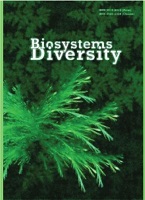Phytochemical profiles and antimicrobial activity of the inflorescences of Sorbus domestica, S. aucuparia, and S. torminalis
Phytochemical profiles and antimicrobial activity of the inflorescences of Sorbus domestica, S. aucuparia, and S. torminalis
Author(s): Y. V. Lykholat, N. O. Khromykh, O. V. Liashenko, T. V. Sklyar, A. O. Anishchenko, O. K. Balalaiev, T. A. Holubieva, T. Y. LykholatSubject(s): Health and medicine and law, Environmental interactions
Published by: Дніпропетровський національний університет імені Олеся Гончара
Keywords: rowans;inflorescences;floral metabolites;GC-MS profiling; chemotaxonomy; antimicrobial ability;
Summary/Abstract: The genus SorbusL. is known for its extremely complex taxonomical relationships and health-promoting phytochemicalsincluded in the composition of itsfloral constituents. The inflorescences of three Sorbus species (rowans), characterized by distinct molecular-genetic traits, were studied in order to examine the possible chemotaxonomic and antimicrobial value of their metabolites. GC–MS profiling of the hexane extracts of S. domestica, S. aucuparia, and S. torminalisinflorescences identified a total of 87 components, which represented six chemical classes (hydrocarbons, alcohols, esters, fatty acid, aldehydes, and ketones) and miscellaneous minor floral constituents (1-methylinosine, 5-amino tetrazole, 1,4-dimethylbenzene, 3,5-bis(1,1-dimethylethyl)-phenol, 3-acetoxy-7,8-epoxylanostan-11-ol, cycloeucalenol acetate, etc.). Principal component analysis (PCA) of the qualitative and quantitative heterogeneity of the floral metabolites determined 1-hentetracontanol, nonacosane, pentadecyl acrylate, 1-methylhexacosane, cycloeucalenol acetate, butyl acetate, and urs-12-ene as the main components which contributed to the differences between S. domestica, S. aucuparia and S. torminalis and resulted in the distinction between the rowan species. Discdiffusion assays showed variability in activity of inflorescence extracts against Gram-negative (Enterobacter dissolvens, Escherichia coli, Pseudomonas aeruginosa, and Klebsiella pneumoniae) and Gram-positive (Micrococcus lysodeikticus, Staphylococcus aureus, and S. epidermidis) bacterial and clinical fungal (Candida albicans) strains. The effect of S. torminalis was high against S. epidermidis and P. aeruginosa, while it was at its lowest against clinical C. albicansstrains. Inflorescences of S. domestica showed the highest inhibition of P. aeruginosa, and moderate effects against S. epidermidis and C. albicans. Inflorescences of S. aucuparia caused low to moderate growth inhibition of both Gram-positive and Gram-negative bacterial strains, while it showed the highest effect on C. albicans. Antimicrobial properties of rowan inflorescences may be attributed to oleic, linoleic, arachidic, hexadecanoic, and pentadecanoic acids, 24-norursa-3,12-diene, hexahydrofarnesyl acetone, cycloeucalenol acetate, and other compounds which have known bioactivity. These findings indicated rowan inflorescences as a rich source of valuable secondary metabolites and allow us to assume an application of the floral constituents as chemotaxonomic markers of the genus Sorbusspecies.
Journal: Biosystems Diversity
- Issue Year: 31/2023
- Issue No: 3
- Page Range: 290-296
- Page Count: 7
- Language: English

